AVL树和红黑树
1. 背景
-
set、map、multiset、multimap,这几个关联式容器的共同点是:底层都是用二叉搜索树来实现的,但二叉搜索树自身有缺陷,若插入的元素有序或者接近有序,二叉搜索树就会退化为单支树,查询时相当于在顺序表中进行查询,效率低下,时间复杂度退化为O(n),因此map、set等关联式容器的底层结构对二叉搜索树进行了平衡处理,即采用平衡树来实现。
-
通过保证每个节点的左、右子树高度差不超过1,对树中的节点进行调整,即可降低树的高度,从而减少树的搜索长度,时间复杂度为O(longn)。
2. AVL树的概念
-
AVL树具有的性质:a. 每个节点的左右子树都是AVL树, b. 每个节点的左右子树高度差(平衡因子)的绝对值不超过1(0、-1、1)。
-
平衡因子:右子树高度-左子树高度,不是必须存在的,只是一种控制方式,帮助我们更便捷的++控制树,检查是否为AVL树。
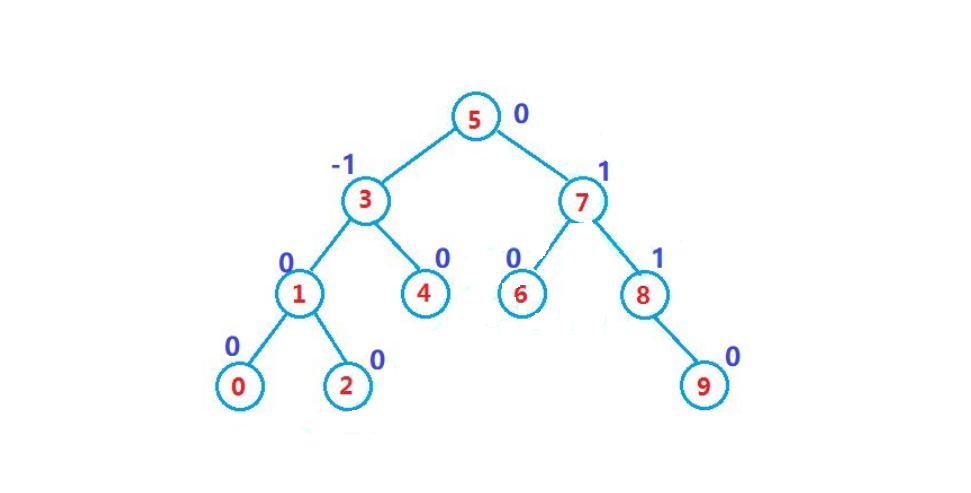
-
如果一颗二叉搜索树高度是平衡的,那么它就是AVL树,如果它有n个节点,它的高度就是longn,则搜索的时间复杂度为O(longn)。
-
无法做到平衡因子的值恒为0,因为二叉树插入节点是一个一个插入进去的,对于2个或者4个节点的树是无法做到左右子树高度差等于0,最优的高度差就是1。
3. AVL树节点的定义
template<class K, class V> //AVL树的节点(KV模型)
struct AVLTreeNode{
typedef AVLTreeNode<K, V> Node;
Node* _left; //该节点的左孩子
Node* _right; //该节点的右孩子
Node* _parent; //该节点的父亲,便于向上更新
int _bf; //该节点的平衡因子
pair<K, V> _kv;
AVLTreeNode(const pair<K, V>& kv) //构造函数
:_kv(kv)
,_left(nullptr)
,_right(nullptr)
,_parent(nullptr)
,_bf(0)
{ }
};
4. AVL树的插入
方法:先按二叉搜索树的方式插入新节点,在更新平衡因子。
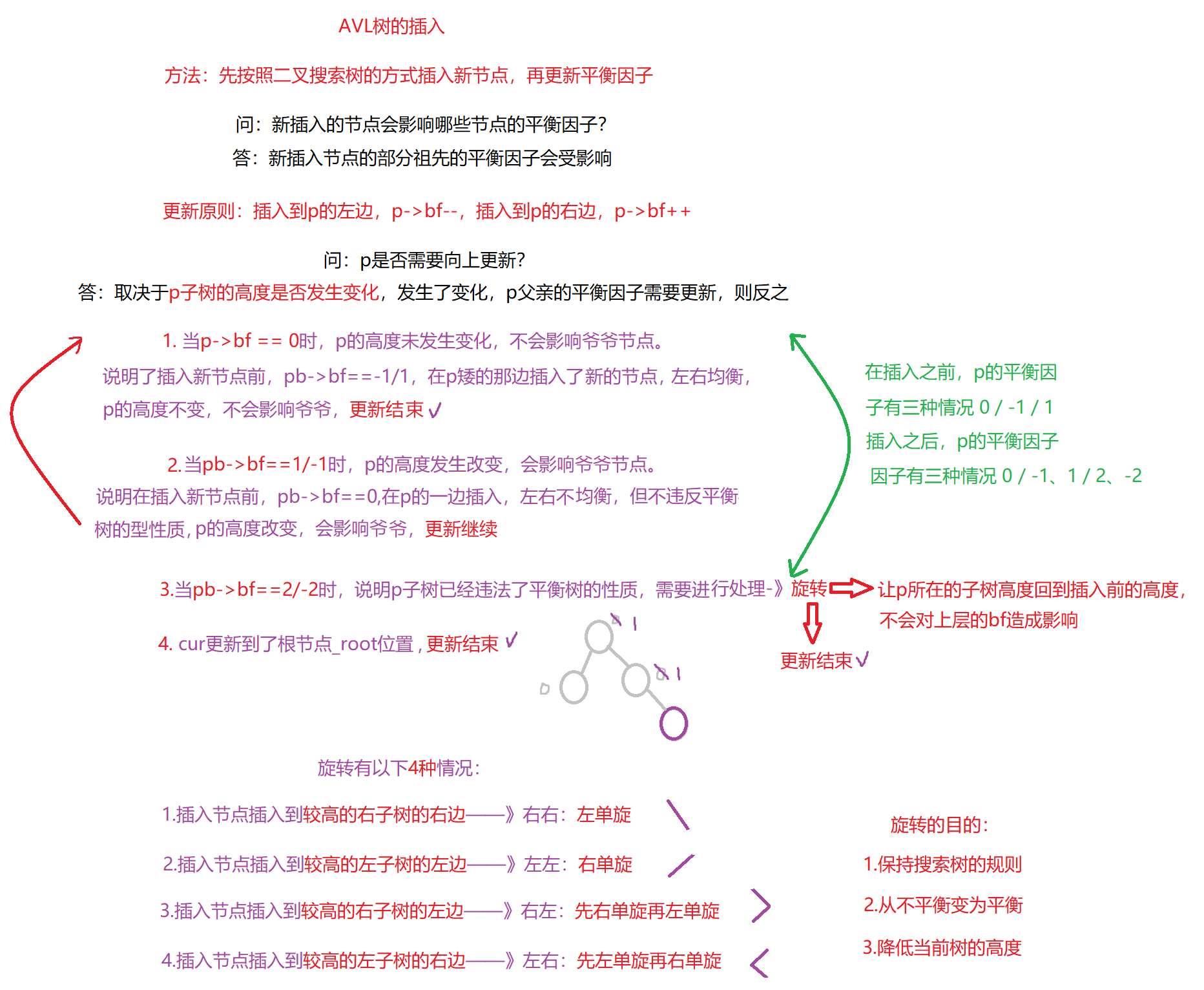
void RotateL(Node* parent) //右右—左单旋
{
Node* subR = parent->_right;
Node* subRL = subR->_left;
Node* pphead = parent->_parent;
parent->_right = subRL; //b变成父节点的右孩子
if (subRL) //当前节点的左孩子可能存在,也可能不存在 h=0,b=0
subRL->_parent = parent; //更新当前节点右孩子的父亲
subR->_left = parent; //父节点变为当前节点的左孩纸
parent->_parent = subR; //更新父节点的父亲
//更新当前节点的父亲,父节点可能为根节点,也可能为根节点
if (parent == _root) //根节点
{
_root = subR;
subR->_parent = nullptr; //更新当前节点的父亲
}
else
{
if (pphead->_left == parent) //子树
pphead->_left = subR;
else
pphead->_right = subR;
subR->_parent = pphead; //更新当前节点的父亲
}
subR->_bf = 0; //更新平衡因子
parent->_bf = 0;
}
void RotateR(Node* parent) //左左—右单旋
{
Node* subL = parent->_left;
Node* subLR = subL->_right;
Node* pphead = parent->_parent;
parent->_left = subLR;
if (subLR)
subLR->_parent = parent;
subL->_right = parent;
parent->_parent = subL;
if (parent == _root)
{
_root = subL;
subL->_parent = nullptr;
}
else
{
if (pphead->_left == parent)
pphead->_left = subL;
else
pphead->_right = subL;
subL->_parent = pphead;
}
subL->_bf = 0; //更新平衡因子
parent->_bf = 0;
}
void RotateRL(Node* parent) //右左—先右旋再左旋
{
Node* subR = parent->_right;
Node* subRL = subR->_left;
Node* bf = subRL->_bf; //因为旋转后会改变bf,需要提前记录
RotateR(subR);
RotateL(parent);
subRL->_bf = 0; //更新平衡因子
if (bf == 0) //情况一:当h = 0,subRL为新增节点
{
subR->_bf = 0;
parent->_bf = 0;
}
else if (bf == -1) //情况二:当h > 0,b插入,b的高度变为h,引发旋转
{
subR->_bf = 1;
parent->_bf = 0;
}
else if(bf == 1) //情况三:当h > 0,c插入,c的高度变为h,引发旋转
{
subR->_bf = 0;
parent->_bf = -1;
}
else //平衡因子异常
{
assert(false);
}
}
void RotateLR(Node* parent) //左右—先左旋再右旋
{
Node* subL = parent->_left;
Node* subLR = subL->_right;
int bf = subLR->_bf;
RotateL(subL);
RotateR(parent);
subLR->_bf = 0; //更新平衡因子
if (bf == 0)
{
subLR->_bf = 0;
parent->_bf = 0;
}
else if (bf == 1)
{
subL->_bf = -1;
parent->_bf = 0;
}
else if(bf == -1)
{
subL->bf = 0;
parent->_bf = 1;
}
else
{
assert(false);
}
}
bool insert(const pair<K, V>& kv) //插入
{
Node* parent = nullptr;
Node* cur = _root;
while (cur) //先按照二叉搜索树的方式插入
{
if (cur->_kv.first < kv.first)
{
parent = cur;
cur = cur->_right;
}
else if (cur->_kv.first > kv.first)
{
parent = cur;
cur = cur->_left;
}
else
{
return false; //不能出现相同值,否则不构成搜索树了
}
}
cur = new Node(kv);
if (parent == nullptr) //空树
{
_root = cur;
return true;
}
if (parent->_kv.first < kv.first)
{
parent->_right = cur;
}
else
{
parent->_left = cur;
}
cur->_parent = parent; //记录当前节点的父亲
while (parent) //更新结束: 情况1,更新到根节点
{
if (parent->_left == cur) //再更新平衡因子
parent->_bf--;
else
parent->_bf++;
if (parent->_bf == 0) //更新结束: 情况2,p的高度不变,不会影响上层的bf
break;
else if (parent->_bf == 1 || parent->_bf == -1) //更新继续:p的高度改变,会影响上层的bf,但未违反平衡树性质
{
cur = cur->_parent;
parent = parent->_parent;
}
else if (parent->_bf == 2 || parent->_bf == -2) //违反了平衡树的规则,做处理-》旋转 ->更新结束
{ //注意:以下4种旋转,只要完成了某一种,都会更新结束,需要break
if (parent->_bf == 2 && cur->_bf == 1) //插入到较高右子树的右边
{
RotateL(parent); //右右—左单旋
break;
}
else if (parent->_bf == -2 && cur->_bf == -1) //插入到较高左子树的左边
{
RotateR(parent); //左左—右单旋
break;
}
else if (parent->_bf == 2 && cur->_bf == -1) //插入到较高右子树的左边
{
RotateRL(parent); //右左—先右旋再左旋
break;
}
else if (parent->_bf == -2 && cur->_bf == 1) //插入到较高左子树的右边
{
RotateLR(parent); //左右—先左旋再右旋
break;
}
else //在插入前就不是AVL树 必须保证再插入前是一颗AVL树
{
assert(false);
break;
}
}
}
}
5. AVL树的旋转
5.1. 左单旋
void RotateL(Node* parent) //右右—左单旋
{
Node* subR = parent->_right;
Node* subRL = subR->_left;
Node* pphead = parent->_parent;
parent->_right = subRL; //b变成父节点的右孩子
if (subRL) //当前节点的左孩子可能存在,也可能不存在 h=0,b=0
subRL->_parent = parent; //更新当前节点右孩子的父亲
subR->_left = parent; //父节点变为当前节点的左孩纸
parent->_parent = subR; //更新父节点的父亲
//更新当前节点的父亲,父节点可能为根节点,也可能为根节点
if (parent == _root) //根节点
{
_root = subR;
subR->_parent = nullptr; //更新当前节点的父亲
}
else
{
if (pphead->_left == parent) //子树
pphead->_left = subR;
else
pphead->_right = subR;
subR->_parent = pphead; //更新当前节点的父亲
}
subL->_bf = 0; //更新平衡因子
parent->_bf = 0;
}
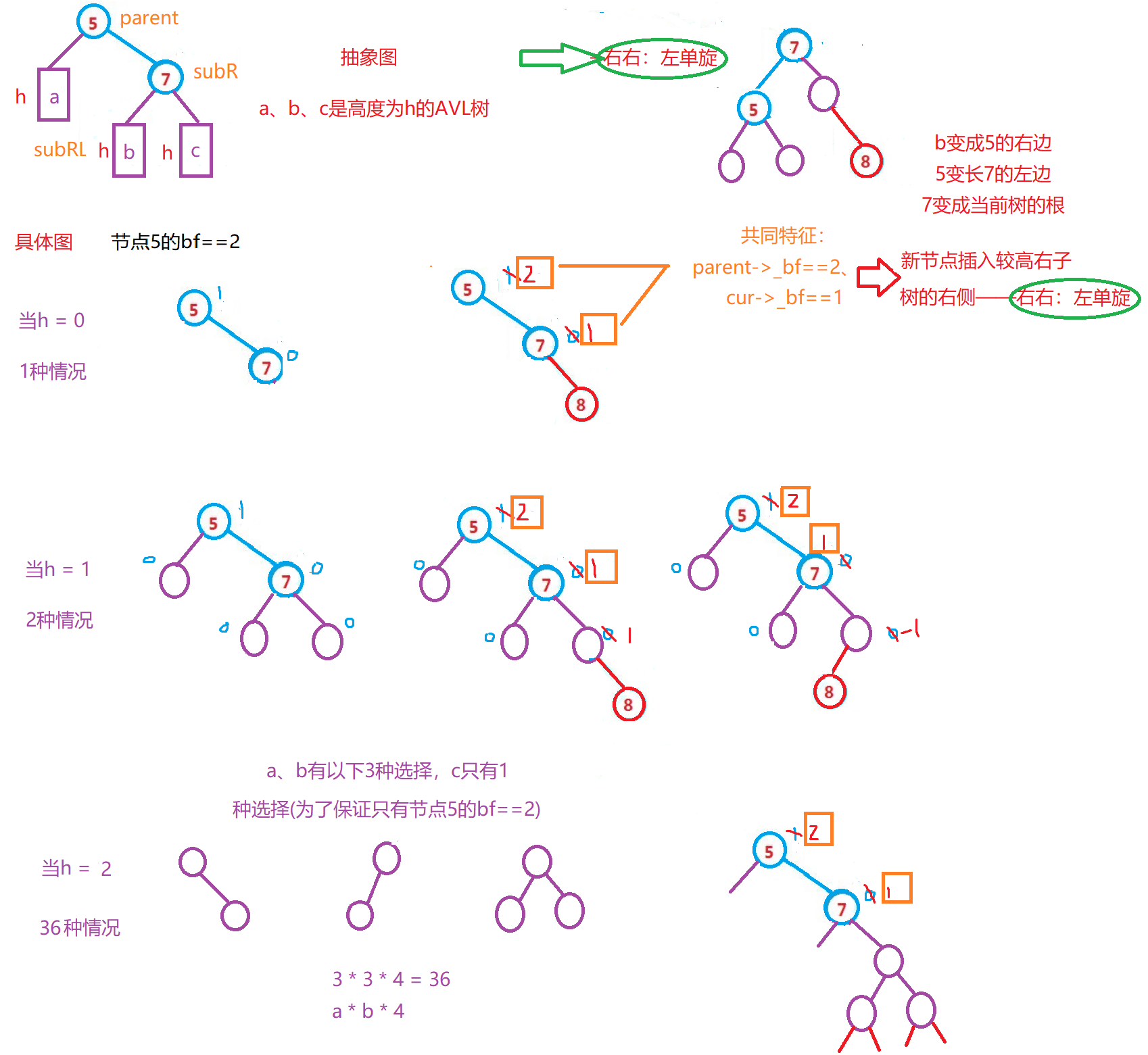
5.2. 右单旋
void RotateR(Node* parent) //左左—右单旋
{
Node* subL = parent->_left;
Node* subLR = subL->_right;
Node* pphead = parent->_parent;
parent->_left = subLR;
if (subLR)
subLR->_parent = parent;
subL->_right = parent;
parent->_parent = subL;
if (parent == _root)
{
_root = subL;
subL->_parent = nullptr;
}
else
{
if (pphead->_left == parent)
pphead->_left = subL;
else
pphead->_right = subL;
subL->_parent = pphead;
}
subL->_bf = 0; //更新平衡因子
parent->_bf = 0;
}

5.3. 左右单旋
void RotateLR(Node* parent) //左右—先左旋再右旋
{
Node* subL = parent->_left;
Node* subLR = subL->_right;
int bf = subLR->_bf;
RotateL(subL);
RotateR(parent);
subLR->_bf = 0; //更新平衡因子
if (bf == 0)
{
subLR->_bf = 0;
parent->_bf = 0;
}
else if (bf == 1)
{
subL->_bf = -1;
parent->_bf = 0;
}
else if(bf == -1)
{
subL->bf = 0;
parent->_bf = 1;
}
else
{
assert(false);
}
}
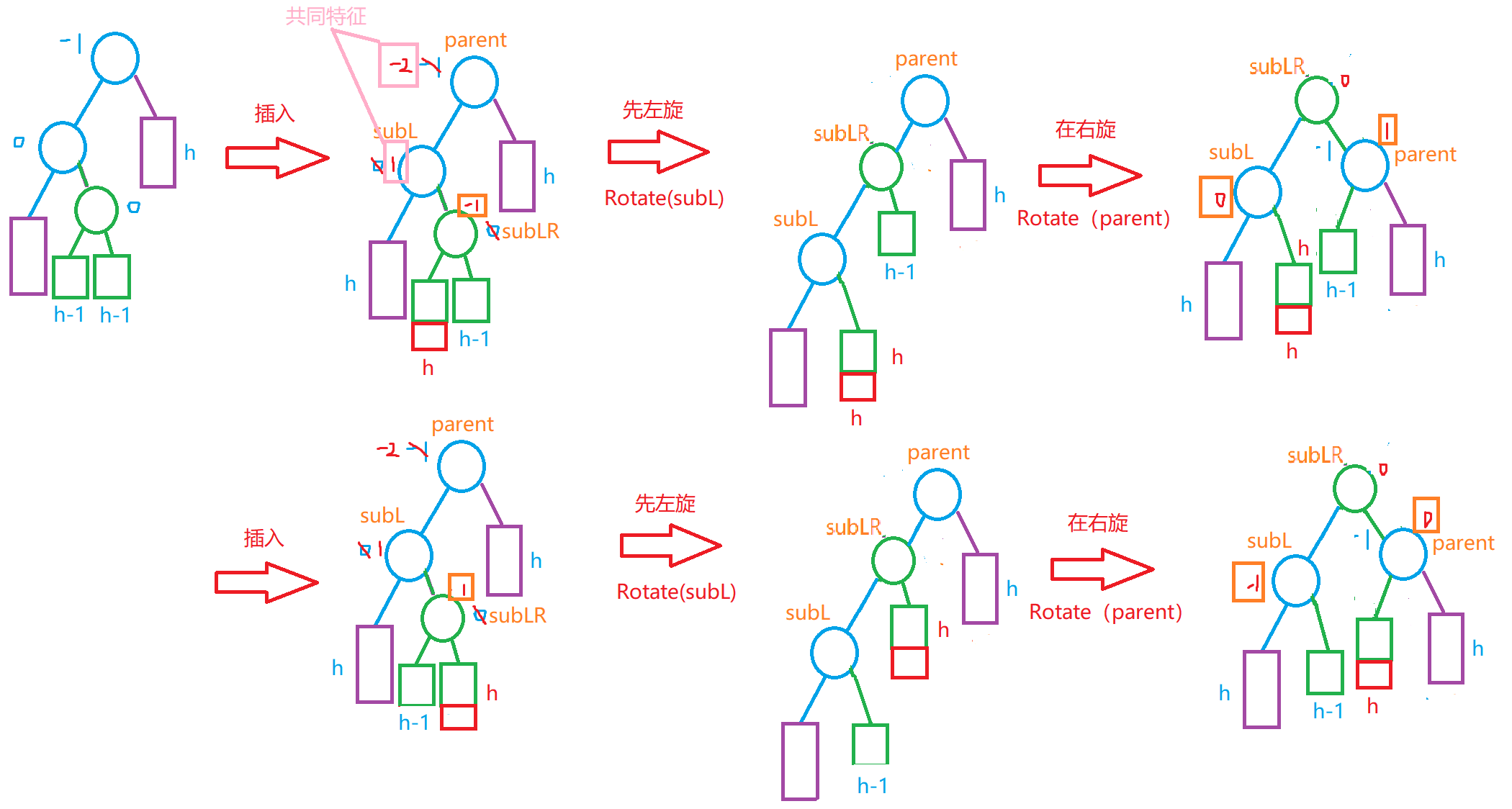
5.4. 右左单旋
void RotateRL(Node* parent) //右左—先右旋再左旋
{
Node* subR = parent->_right;
Node* subRL = subR->_left;
Node* bf = subRL->_bf; //因为旋转后会改变bf,需要提前记录
RotateR(subR);
RotateL(parent);
subRL->_bf = 0; //更新平衡因子
if (bf == 0) //情况一:当h = 0,subRL为新增节点
{
subR->_bf = 0;
parent->_bf = 0;
}
else if (bf == -1) //情况二:当h > 0,b插入,b的高度变为h,引发旋转
{
subR->_bf = 1;
parent->_bf = 0;
}
else if(bf == 1) //情况三:当h > 0,c插入,c的高度变为h,引发旋转
{
subR->_bf = 0;
parent->_bf = -1;
}
else //平衡因子异常
{
assert(false);
}
}
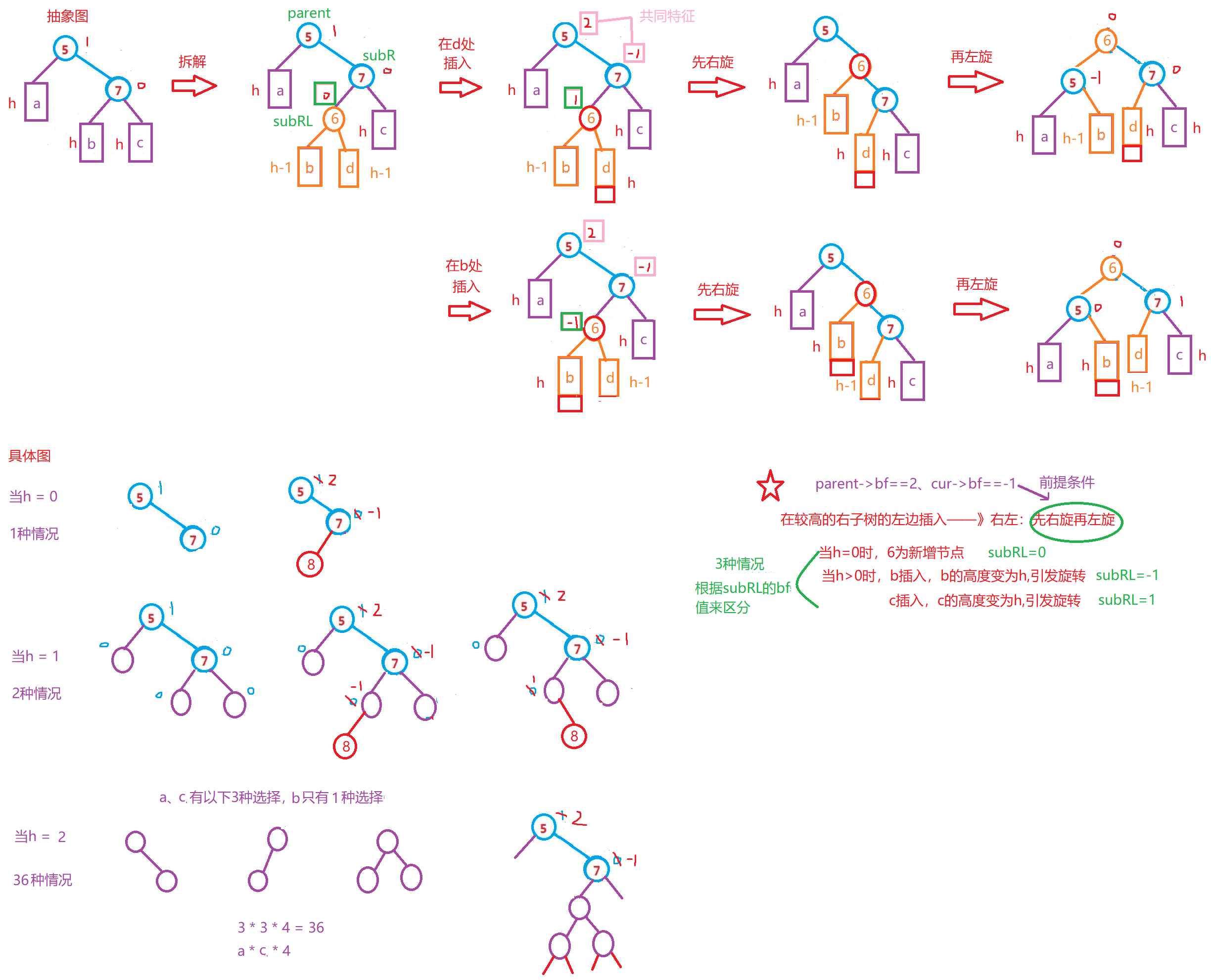
5.5. 旋转总结
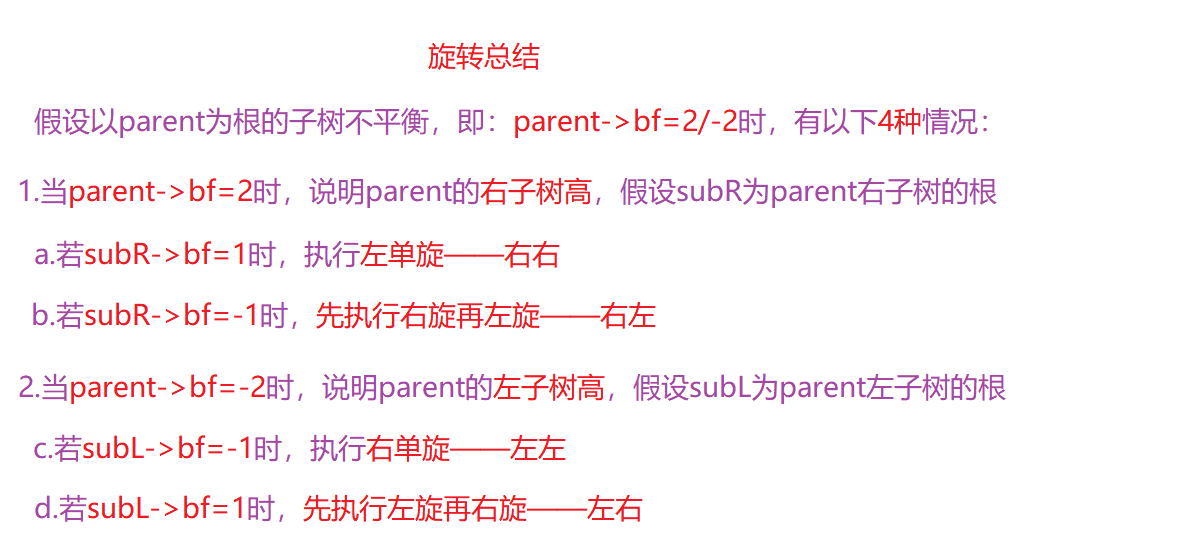
6. AVL树的验证
方法:先验证其为二叉搜索树(中序遍历得到有序序列),再验证其为平衡树(左右子树高度差的绝对值不超过1、平衡因子正常)。
int _Height(Node* root) //后序遍历
{
if (root == nullptr)
return 0;
int leftHeight = _Height(root->_left);
int rightHeight = _Height(root->_right);
return leftHeight > rightHeight ? leftHeight + 1 : rightHeight + 1;
}
bool _Isbalance(Node* root) //前序遍历 验证其为平衡树
{
if (root == nullptr)
return true;
int leftHeight = _Height(root->_left);
int rightHeight = _Height(root->_right);
if (abs(rightHeight - leftHeight) >= 2)
{
cout << "不平衡" << endl;
return false;
}
if (rightHeight - leftHeight != root->_bf)
{
cout << root->_kv.first << ":平衡因子异常" << endl;
return false;
}
return _Isbalance(root->_left) && _Isbalance(root->_right);
}
void _Inorder(Node* root) //中序遍历 验证其为二叉搜索树
{
if (root == nullptr)
return;
_Inorder(root->_left);
cout << root->_kv.first << "[" << root->_bf << "]" << endl;
_Inorder(root->_right);
}
-
不能采用层序遍历、看bf的值,原因:对于完全二叉树、满二叉树通过层序遍历可以推出树的正确结构,AVL树不一定为完全、满二叉树。在旋转时,bf可能更新异常,此时看bf的值,会造错误构。
-
验证其为平衡二叉树,采用前序遍历,缺点:先求高度,再判平衡,递归式判子树平衡,导致重复求子树的高度,效率低——》解决方法:将前序改成后序,并将高度作为引用参数(引用,各个栈帧相互影响),边判平衡边求高度。
bool _Isbalance(Node* root, int& height) //后序遍历+引用参数
{
if (root == nullptr) //空树也是AVL树
{
height = 0;
return true;
}
int leftHeight = 0, rightHeight = 0;
if(!_Isbalance(root->_left, leftHeight) || !_Isbalance(root->_right, rightHeight))
return false; //只要左右子树有一颗不是平衡树,该树就不是平衡树
height = leftHeight > rightHeight ? leftHeight + 1 : rightHeight + 1;
return true;
}
int main()
{
int a[] = { 8, 5, 2, 6, 3, 7, 4, 1 };
AVLTree<int, int> t;
for (auto& e : a)
{
t.insert(make_pair(e, e));
}
t.Inorder();
cout << t.Isbalance() << endl;
return 0;
}


7. AVL树的性能
-
AVL是一颗高度平衡的二叉搜索树,查询时效率高,时间复杂度为O(longn),但如果要对AVL树进行结构修改操作,性能非常低,如:插入时,为了维持平衡需要进行多次旋转,删除可能旋转要持续到根节点位置处。
-
如果需要一种查询高效且数据有序的数据结构,数据的个数为静态的(不会插入元素,结构不会发生改变),可以考虑使用AVL树。如果一个结构需要经常的修改,AVL树不太适用。
8. 红黑树的概念
-
红黑树的概念:红黑树,是一种二叉搜索树,在每个节点上增加一个存储位来表示节点的颜色,red或者black,通过对每条路径上节点着色方式的控制,红黑树保证了最长路径不超过最短路径的二倍,其他路径的长度位于最短路径长度和最长路径长度之间,即:每条路径不会比其他路径长出两倍,因此它接近于平衡。
-
红黑树的性质
a.每个节点的颜色不是红色就是黑色 ;
b.根节点的颜色一定是黑色 ;
c.如果有一个节点的颜色是红色,则它的孩子节点的颜色一定是黑色,即:没有连续的红色节点;
d.每条路径都具有相同数量的黑色节点。
e.每个叶子节点都是黑色的,叶子节点指的是空节点,又名为NIL节点,是为了避免路径(根节点到空节点)数错的误区。 -
问:只要满足以上的性质,为什么红黑树就能保证最长路径中节点个数不超过最短路径中节点个数的两倍?
答:因为在极端情况下,最短路径:全黑,最长路径:一黑一红。

9. 红黑树的节点的定义
enum Color { //枚举,一一列举出事物具有的所有可能
Red, //枚举常量,给枚举变量进行赋值
Black,
};
template<class K, class V>//红黑树的节点(KV模型)
struct RBTreeNode {
typedef RBTreeNode<K, V> Node;
Node* _left; //该节点的左孩子
Node* _right; //该节点的右孩子
Node* _parent; //该节点的父亲,便于向上更新
pair<K, V> _kv;
Color _col;
RBTreeNode(const pair<K, V>& kv, Color col = Red) //构造函数
:_kv(kv)
, _left(nullptr)
, _right(nullptr)
, _parent(nullptr)
, _col(col) //默认新插入节点的颜色为红色
{ }
};
10. 红黑树的插入
方法:先按照二叉搜素树的方式插入,在更新颜色。
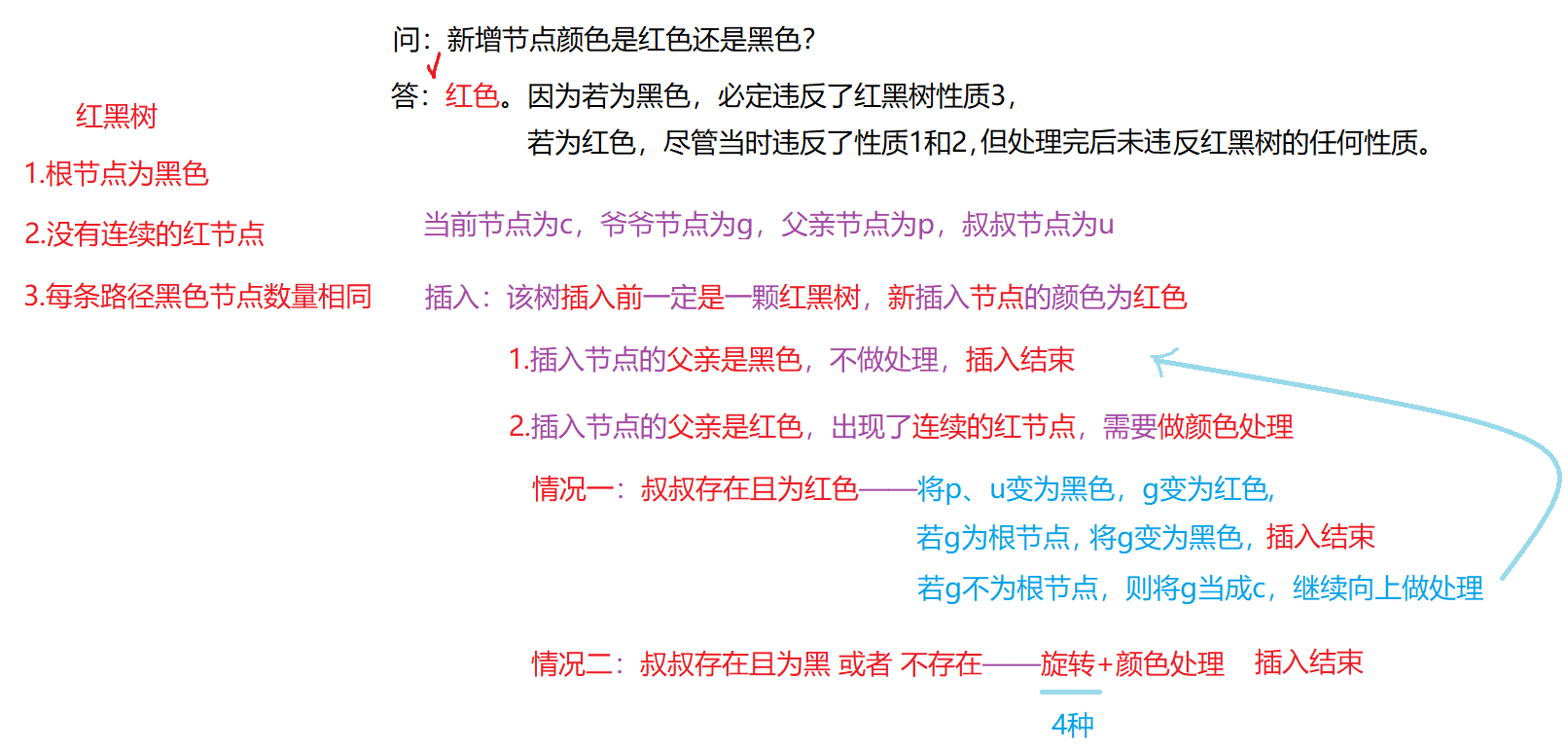
void RotateL(Node* parent) //右右—左单旋
{
Node* subR = parent->_right;
Node* subRL = subR->_left;
Node* pphead = parent->_parent;
parent->_right = subRL;
if (subRL)
subRL->_parent = parent;
subR->_left = parent;
parent->_parent = subR;
if (parent == _root)
{
_root = subR;
subR->_parent = nullptr;
}
else
{
if (pphead->_left == parent)
pphead->_left = subR;
else
pphead->_right = subR;
subR->_parent = pphead;
}
}
void RotateR(Node* parent) //左左—右单旋
{
Node* subL = parent->_left;
Node* subLR = subL->_right;
Node* pphead = parent->_parent;
parent->_left = subLR;
if (subLR)
subLR->_parent = parent;
subL->_right = parent;
parent->_parent = subL;
if (parent == _root)
{
_root = subL;
subL->_parent = nullptr;
}
else
{
if (pphead->_left == parent)
pphead->_left = subL;
else
pphead->_right = subL;
subL->_parent = pphead;
}
}
void RotateRL(Node* parent) //右左—先右旋再左旋
{
Node* subR = parent->_right;
Node* subRL = subR->_left;
RotateR(subR);
RotateL(parent);
}
void RotateLR(Node* parent) //左右—先左旋再右旋
{
Node* subL = parent->_left;
Node* subLR = subL->_right;
RotateL(subL);
RotateR(parent);
}
bool insert(const pair<K, V>& kv) //插入
{
Node* parent = nullptr;
Node* cur = _root;
while (cur) //先按照二叉搜索树的方式插入
{
if (cur->_kv.first < kv.first)
{
parent = cur;
cur = cur->_right;
}
else if (cur->_kv.first > kv.first)
{
parent = cur;
cur = cur->_left;
}
else
{
return false; //不能出现相同值,否则不构成搜索树了
}
}
cur = new Node(kv);
if (parent == nullptr) //空树
{
_root = cur;
_root->_col = Black; //跟节点为黑
return true;
}
if (parent->_kv.first < kv.first)
{
parent->_right = cur;
}
else
{
parent->_left = cur;
}
cur->_parent = parent; //记录当前节点的父亲
//更新颜色
//插入结束:1.插入节点的父亲是黑色,因为插入前该树就为红黑树 2.情况一处理完后,cur为根节点,且为黑色
while (parent && parent->_col == Red)
{ //爷爷一定存在,因为c为红,p为红,所以p一定不是根节点,且一定有父节点
Node* grandfather = parent->_parent;
if (parent == grandfather->_left) //旋转需要确定方向
{
Node* uncle = grandfather->_right;
if (uncle && uncle->_col == Red) //情况一:叔叔存在且为红->无方向(p、u为g的任意边,c为p的任一边)
{ //cur可能为新增节点,也可能一开始为黑色,cur的子树(下一层为红,下一层为新插入节点)在调整过程中将cur由黑变为红
parent->_col = uncle->_col = Black; //p、u变为黑,g变为红
grandfather->_col = Red;
//g可能为根节点(更新结束),也可能为子树(继续向上更新)
cur = grandfather;
parent = cur->_parent;
}
else //情况二:叔叔不存在 或者 叔叔存在且为黑
{ //叔叔不存在,cur为新增节点 或 cur原来为黑,经子树调整由黑变红
if (parent->_left == cur) //左左——右单旋
{
RotateR(grandfather);
parent->_col = Black; //p变为黑,g变为红
grandfather->_col = Red;
}
else //左右——左右单旋
{
RotateL(parent);
RotateR(grandfather);
cur->_col = Black; //c变黑,g变红
grandfather->_col = Red;
}
break; //更新结束:3.旋转+颜色处理后就是红黑树了
}
}
else
{
Node* uncle = grandfather->_left;
if (uncle && uncle->_col == Red)
{
parent->_col = uncle->_col = Black;
grandfather->_col = Red;
cur = grandfather;
parent = cur->_parent;
}
else
{
if (parent->_right == cur) //右右——左单旋
{
RotateL(grandfather);
parent->_col = Black;
grandfather->_col = Red;
}
else //右左——右左单旋
{
RotateR(parent);
RotateL(grandfather);
cur->_col = Black;
grandfather->_col = Red;
}
break;
}
}
}
_root->_col = Black; //g为根,颜色变为黑,更新结束
return true; //情况一,插入节点的父亲为黑,插入结束
}
10.1. 情况一
-
叔叔存在且为红色——将p、u变为黑色,g变为红色,在把g给c。若c为根节点,将c变为黑色,插入结束(break)。若c不为根节点,继续向上更新颜色,直到c为根 或则 c的父亲为黑色。
-
无方向——p、u是g的左右都可以,c是p的左右都可以,处理方式都是一样的。
if (uncle && uncle->_col == Red) //情况一:叔叔存在且为红->无方向(p、u为g的任意边,c为p的任一边)
{ //cur可能为新增节点,也可能一开始为黑色,cur的子树(下一层为红,下一层为新插入节点)在调整过程中将cur由黑变为红
parent->_col = uncle->_col = Black; //p、u变为黑,g变为红
grandfather->_col = Red;
//g可能为根节点(更新结束),也可能为子树(继续向上更新)
cur = grandfather;
parent = cur->_parent;
}
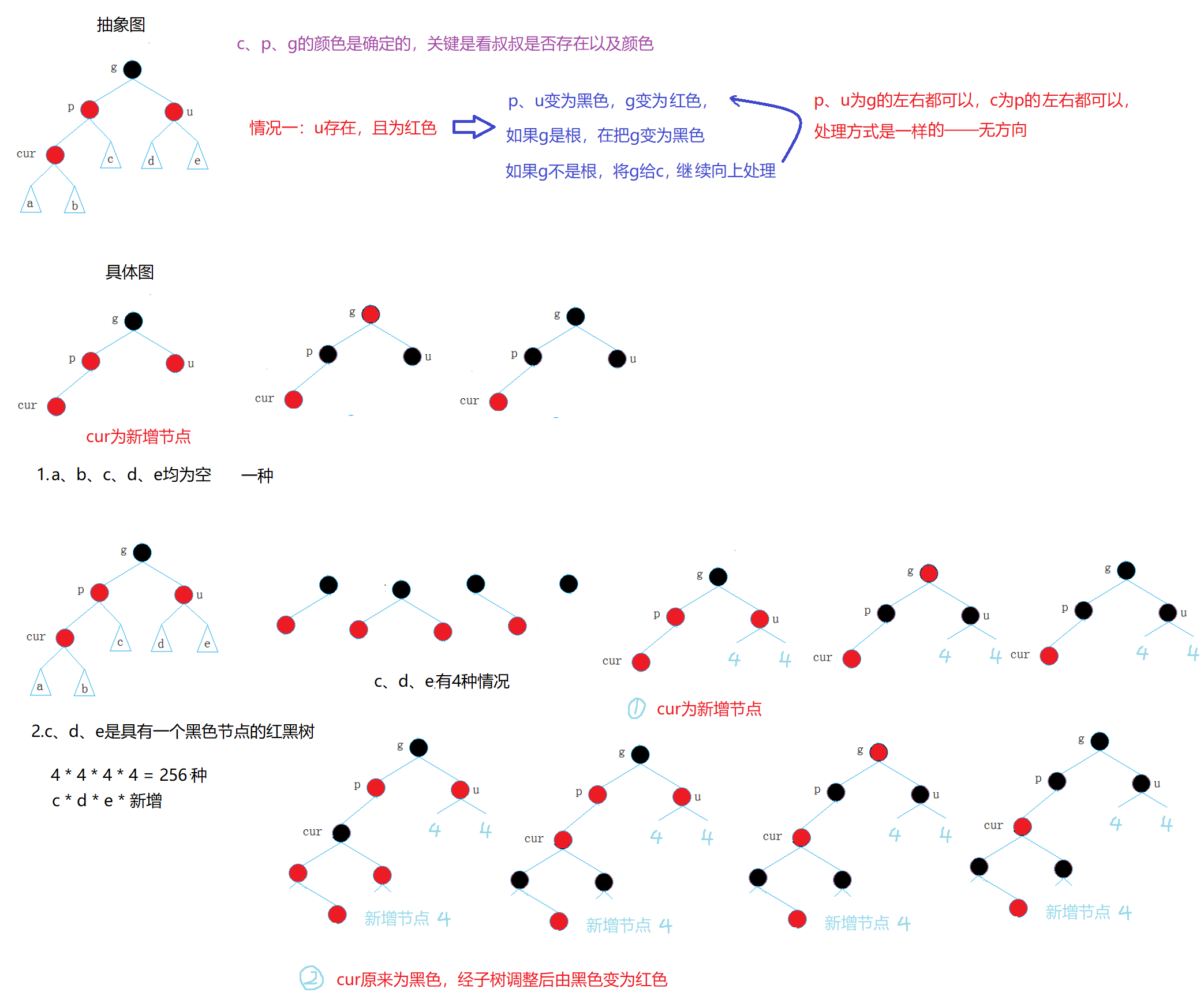
10.2.情况二
-
叔叔不存在 或者 叔叔存在且为黑色——旋转(有方向,4种) + 颜色处理。
-
a. p为g的左孩子,c为p的左孩子,左左,右单旋。b. p为g的右孩子,c为p的右孩子,右右,左单旋,将p变为黑色,将g变为红色—》将p变为黑色,将g变为红色。c. p为g的左孩子,c为p的右孩子,左右旋。d. p为g的右孩子,c为p的左孩子,右左旋——》将c变为黑色,g变为红色。
-
若叔叔不存在,c只可以是新增节点,因为若c不是新增节点,该树最短路径长度为1,最长路径长度为4,在插入前就已经违反了红黑树性质3。若叔叔存在且为红,c只能是原来为黑色,经子树调整由黑色变为红色。
-
情况二在插入前最短路径长度:最短路径长度=1:2,插入后,违反了红黑树性质4,所以需要做旋转处理。
if (parent->_left == cur) //左左——右单旋
{
RotateR(grandfather);
parent->_col = Black; //p变为黑,g变为红
grandfather->_col = Red;
}
else //左右——左右单旋
{
RotateL(parent);
RotateR(grandfather);
cur->_col = Black; //c变黑,g变红
grandfather->_col = Red;
}
break; //更新结束:3.旋转+颜色处理后就是红黑树了
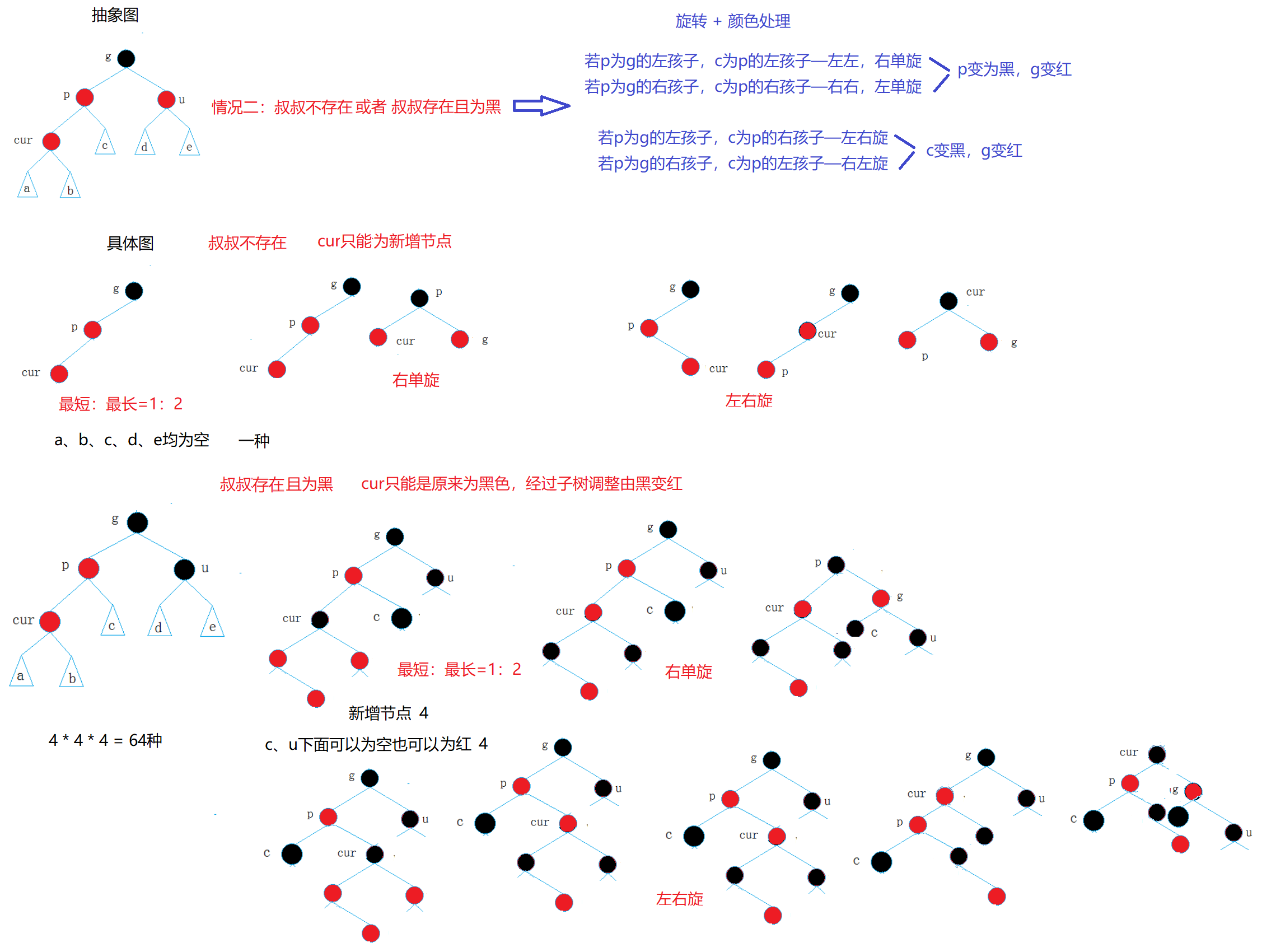
11. 红黑树的验证
方法:先验证其为二叉搜索树(中序遍历得到有序序列),再验证其是否满足红黑树的性质。
void Inorder() //验证其为二叉搜索树,中序遍历
{
_Inorder(_root);
}
bool Balance() //验证其是否满足红黑树的性质
{
if (_root && _root->_col == Red) //红黑树性质2,跟节点为黑色
return false;
int refvalue = 0; //红黑树性质4,每条路径具有相同数量的黑节点
Node* cur = _root;
while (cur)
{
if (cur->_col == Black)
refvalue++; //找参考值
cur = cur->_left;
}
_Balance(_root, 0, refvalue);
}
//前序遍历,将每条路径黑色节点的数量于参考值比较,验证性质4
bool _Balance(Node* root, int blackcount, int& refvalue)
{
if (root == nullptr)
{
if (blackcount != refvalue)
return false;
return true;
}
if (root->_col == Red && root->_parent->_col == Red)
return false; //验证红黑性质3,没有连续的红节点,孩子找爹
if (root->_col == Black) //blackcount没有用引用,因为下层不能影响上次,blackcount表示的是当前节点到根节点路径上黑色节点的数量
blackcount++;
return _Balance(root->_left, blackcount, refvalue) && _Balance(root->_right, blackcount, refvalue); //放在后面,从前往后
}
void _Inorder(Node* root) //中序遍历
{
if (root == nullptr)
return;
_Inorder(root->_left);
cout << root->_kv.first << endl;
_Inorder(root->_right);
}
#define _CRT_SECURE_NO_WARNINGS 1
#include"RBTree.h"
void test1()
{
int a[] = { 5, 4, 8, 6, 2, 9, 1, 3, 7 };
RBTree<int, int> rb;
for (auto& e : a)
{
rb.insert(make_pair(e, e));
}
rb.Inorder();
cout << rb.Balance() << endl;
}
int main()
{
test1();
return 0;
}


12. 红黑树与AVL树的比较
-
红黑树和AVL树都是高效的平衡二叉搜索树,增删查改的时间复杂度都为O(longn),但红黑树不要求绝对平衡,只需保证最长路径的长度不超过最短路径长度的两倍,相对而言,降低了插入、删除时旋转的次数,所以在经常进行增删查改的结构中红黑树的性能更优,在实际应用红黑树的更多。
-
AVL树的高度接近于longn,红黑树的高度接近于2longn,所以搜索效率AVL树略优于红黑树,但是几乎可以忽略不记,因为n足够大时,longn就足够小,两者的差距微乎其微。当插入同样得数据,AVL树的高度更低,通过多次旋转达到的。





















 633
633

 被折叠的 条评论
为什么被折叠?
被折叠的 条评论
为什么被折叠?








